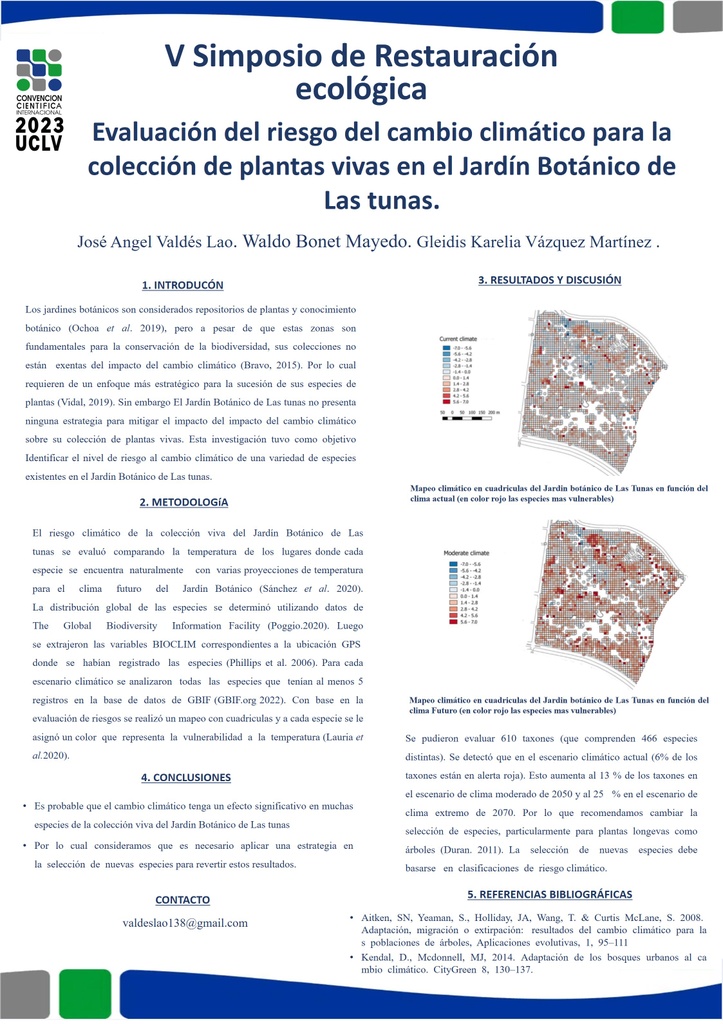Executive Secretary

9th International Scientific Conference on Agricultural Development and Sustainability
5th Symposium of Ecological Restoration

Abstract
Botanical gardens are considered repositories of plants and botanical knowledge, but despite the fact that these areas are fundamental for the conservation of biodiversity, their collections are not exempt from the impact of climate change. Therefore, they require a more strategic approach to the succession of their plant species. However, the Botanical Garden of Las Tunas does not present any strategy to mitigate the impact of the impact of climate change on its collection of living plants. Therefore, this research aimed to identify the level of risk to climate change of a variety of species existing in the Botanical Garden of Las Tunas. The climatic risk of the living collection of the Botanical Garden of Las Tunas was evaluated by comparing the temperature of the places where each species occurs naturally, with various temperature projections for the future climate of the Botanical Garden of Las Tunas. 610 taxa (comprising 466 distinct species) could be evaluated. It was detected that in the current climate scenario (6% of taxa are on red alert). This increases to 13% of taxa in the moderate climate scenario of 2050 and to 25% in the extreme climate scenario of 2070. The results indicate that climate change is likely to have a significant effect on many species in the living collection of the Botanical Garden of Las Tunas. Therefore, we believe that it is necessary to apply a strategy to reverse these results.
Resumen
Los jardines botánicos son considerados repositorios de plantas y conocimiento botánico, pero a pesar de que estas zonas son fundamentales para la conservación de la biodiversidad, sus colecciones no están exentas del impacto del cambio climático. Por lo cual requieren de un enfoque más estratégico para la sucesión de sus especies de plantas. Sin embargo El Jardín Botánico de Las tunas no presenta ninguna estrategia para mitigar el impacto del impacto del cambio climático sobre su colección de plantas vivas. Por lo cual esta investigación tuvo como objetivo Identificar el nivel de riesgo al cambio climático de una variedad de especies existentes en el Jardín Botánico de Las tunas. El riesgo climático de la colección viva del Jardín Botánico de Las tunas se evaluó comparando la temperatura de los lugares donde cada especie se encuentra naturalmente, con varias proyecciones de temperatura para el clima futuro del Jardín Botánico de Las tunas. Se pudieron evaluar 610 taxones (que comprenden 466 especies distintas). Se detectó que en el escenario climático actual (6% de los taxones están en alerta roja). Esto aumenta al 13 % de los taxones en el escenario de clima moderado de 2050 y al 25 % en el escenario de clima extremo de 2070. Los resultados indican que es probable que el cambio climático tenga un efecto significativo en muchas especies de la colección viva del Jardín Botánico de Las tunas. Por lo cual consideramos que es necesario aplicar una estrategia para revertir estos resultados.
About The Speaker

José Angel Valdés Lao

Discussion

